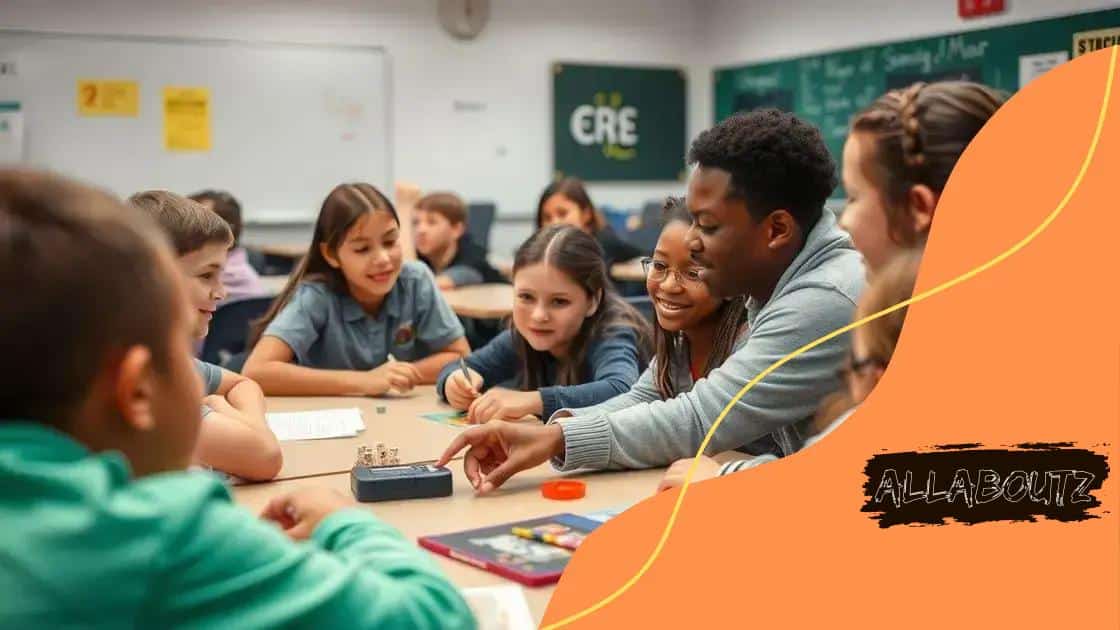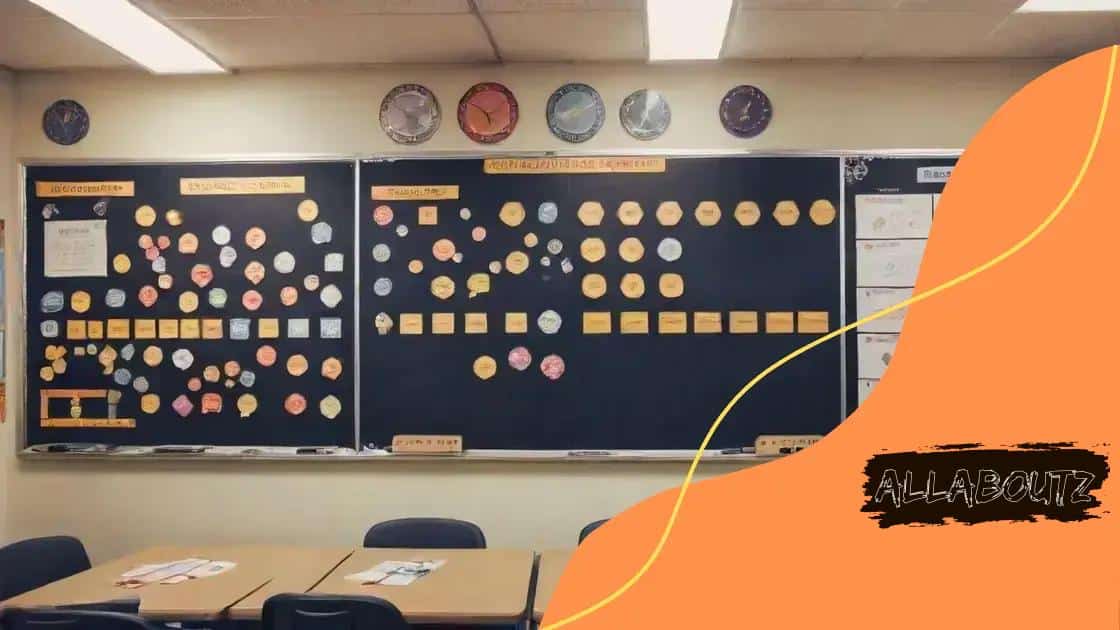Gamification for enhancing student learning outcomes

Gamification enhances student learning outcomes by increasing engagement, motivation, and performance through the integration of game elements like points, badges, and interactive activities in educational settings.
Gamification for enhancing student learning outcomes is more than a buzzword; it’s a transformative approach in education. Imagine a classroom where learning feels like play, engaging students like never before. Let’s dive into how gamification can make a real difference for learners.
Understanding gamification in education
Understanding gamification in education is essential for today’s teachers. It’s an innovative way to engage students, making learning more interactive and enjoyable. By incorporating game mechanics into the learning process, teachers can motivate students to participate actively.
What is Gamification?
At its core, gamification involves applying game elements to non-game contexts. This technique transforms typical learning experiences, encouraging students to achieve goals and earn rewards.
Key Elements of Gamification
- Points: Rewarding students points for completing tasks.
- Badges: Providing badges for achieving specific milestones.
- Leaderboards: Displaying rankings to foster competition.
- Levels: Allowing students to progress through various levels of difficulty.
These elements can significantly enhance motivation and increase engagement among students. For example, when students see their points accumulating or earn badges for their efforts, they feel a sense of achievement.
Moreover, gamification makes learning enjoyable. When learning feels like a game, students are more likely to participate willingly. This can be especially helpful in subjects that students find challenging.
In addition, gamification encourages collaboration among students. Many games require teamwork, which can help build social skills. When students work together to solve problems or achieve goals, they learn to communicate and collaborate effectively.
As educators explore different ways to motivate students, gamification emerges as a powerful tool. Integrating game mechanics into lesson plans can lead to higher student engagement and improved learning outcomes.
Benefits of gamification for student engagement
The benefits of gamification for student engagement are vast and impactful. By applying game principles to learning, students become more involved and excited about their education. This approach not only makes the classroom experience more enjoyable but also develops important skills.
Increased Motivation
One major benefit of gamification is that it significantly increases student motivation. When students are rewarded for achievements, they are more likely to engage actively in the learning process. Gamified tasks create a sense of urgency and competition, motivating students to participate fully.
Enhanced Learning Experience
- Interactive Learning: Students learn better when engaged through interactive methods.
- Immediate Feedback: Gamification offers real-time feedback, helping students understand their progress.
- Fun Environment: Bringing fun into lessons keeps students interested and eager.
- Goal Setting: Clear objectives encourage students to work towards specific goals.
In addition to motivation, gamification enhances the overall learning experience. It turns traditional teaching methods into an exciting adventure. As students navigate through challenges and rewards, they retain information better.
Furthermore, this approach supports skill development. As students solve problems in a game-like setting, they improve critical thinking and collaboration. They learn to communicate effectively while working as a team, which is essential in today’s world.
Overall, the benefits of gamification extend beyond simple engagement. This method fosters a love for learning while helping students develop the skills they need for the future. With constant innovation in educational methods, embracing gamification can lead to significant improvements in student outcomes.
Effective strategies to implement gamification

Effective strategies to implement gamification can transform a classroom. By using game-like elements in lessons, teachers can enhance student engagement and motivation. It’s important to tailor these strategies to fit the needs of the classroom and the students.
Start with Clear Objectives
First, it’s critical to establish clear objectives for your gamification efforts. Students should understand what they are working towards. This clarity helps keep students focused and motivated. Make sure the goals are achievable yet challenging to encourage effort.
Incorporate Game Mechanics
- Points System: Create a system where students earn points for completing tasks.
- Badges and Rewards: Implement badges for achievements to encourage progress.
- Challenges: Introduce challenges that students can complete individually or in groups.
- Progress Tracking: Use visual trackers to show progress and achievements.
In addition to these mechanics, creating a storyline can increase engagement. A narrative can provide context and make learning feel more relevant. For instance, students can embark on a mission, turning their educational journey into an adventure.
Another strategy is to encourage collaboration. Group activities allow students to work together and learn from each other. This not only builds teamwork skills but also reinforces learning concepts through discussion and cooperation.
Regular feedback is essential in any gamification strategy. Providing immediate feedback keeps students informed of their progress and helps them adjust their approach when needed. It also builds confidence as students see their growth throughout the learning process.
When implementing gamification, remember to gather feedback from students. This feedback can guide future strategies and modifications. Adjusting the approach based on student responses ensures the gamification remains effective and engaging.
Examples of successful gamification in classrooms
Examples of successful gamification in classrooms show how this approach can transform student learning. Many educators have found creative ways to incorporate game-like elements into their teaching, leading to increased engagement and motivation.
Classroom Quest
One effective example is the Classroom Quest, a role-playing game where students embark on educational missions. Students create characters and complete tasks to earn points. As they succeed, they unlock new levels and rewards. This method encourages collaboration and makes learning feel like an adventure.
Math Bingo
- Incorporating Game Mechanics: Math Bingo combines traditional Bingo with math problems. Students solve problems to fill their cards, turning a classic game into a fun learning tool.
- Engagement Boost: This method keeps students actively involved as they work to complete their cards.
- Peer Learning: Working in pairs or small groups reinforces learning, as students discuss solutions.
Another successful implementation is the use of leaderboards. In this case, teachers display top performers for various subjects. This not only fosters friendly competition but also encourages students to improve. They can see their progress and strive to climb the rankings.
Story-based learning is also a great example of gamification. Teachers create narratives that guide lessons, making the material more relatable. For instance, turning a history lesson into a quest helps students connect with the content better. Students become more invested as they navigate through a storyline.
Additionally, using digital tools like Kahoot! offers an interactive way to conduct quizzes. Students can compete against each other in real-time. This immediate feedback keeps them engaged and motivated to learn, making assessments feel more like games.
Measuring the impact of gamification on learning outcomes
Measuring the impact of gamification on learning outcomes is essential for educators. By evaluating how game elements influence student performance, teachers can refine their strategies and ensure effective learning.
Identifying Key Metrics
First, it’s important to identify key metrics to evaluate. Common metrics include student engagement, test scores, and retention rates. Tracking these can provide insight into the effectiveness of gamification in your classroom.
Using Surveys and Feedback
- Student Surveys: Conduct surveys to gather student opinions on gamified activities.
- Feedback Sessions: Hold discussions to understand their experiences with gamified learning.
- Performance Reviews: Review how well students perform in gamified tasks versus traditional methods.
Gathering student feedback can highlight what aspects of gamification are working well and what may need adjustment. Frequent feedback encourages ongoing improvement and student satisfaction.
Another effective way to measure impact is through pre-and post-assessments. By evaluating student knowledge before and after implementing gamified strategies, teachers can directly observe improvements in understanding. This method can also help in adjusting educational approaches to better fit students’ needs.
Additionally, analyzing participation rates during gamified sessions offers insight into student engagement. High participation often correlates with increased motivation and improved learning outcomes. It’s important to compare participation levels in both gamified and traditional activities to see the differences.
Finally, consider using technology tools to track progress. Online platforms can provide valuable analytics, showing trends in student performance over time. These metrics help schools assess the overall effectiveness of gamification as a teaching technique.
In summary, integrating gamification in education leads to numerous benefits. It enhances student engagement, boosts motivation, and improves academic performance. By using effective strategies and techniques, teachers can create an exciting and dynamic learning environment. Measuring the impact of these methods helps educators refine their approaches and ensure students succeed. Embracing gamification opens new avenues for effective teaching and learning.
FAQ – Frequently Asked Questions about Gamification in Education
What is gamification and how does it work in education?
Gamification involves using game elements, like points and rewards, in learning to motivate and engage students.
How can gamification improve student learning outcomes?
By making learning fun and interactive, gamification increases motivation, enhances engagement, and boosts academic performance.
What are some effective strategies for implementing gamification?
Effective strategies include setting clear objectives, using game mechanics, and encouraging collaboration among students.
How can teachers measure the impact of gamification?
Teachers can measure impact through student feedback, assessments, participation rates, and tracking performance metrics over time.





